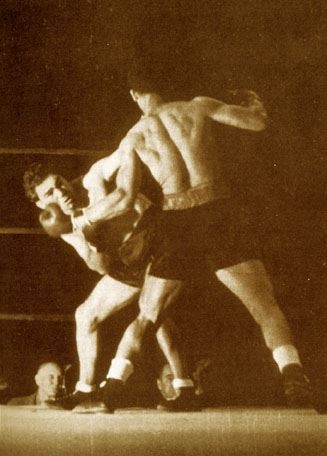 |
In the 1930s and 1940s, the Great Depression and World War II shook up the nation and changed people’s lives. In the U.S. and around the world, people were dying both on the home front and battle lines. People needed something or someone to pull their attention from all of the negativity surrounding them. Sports helped to do this. Sports have helped people cope with different things, like war, famine, poverty, etc., ever since the first one was invented. During this time, many athletes became famous. Some of these athletes were seen as just that, athletes. However, a few were seen in a different light, and came to mean more. One such person was Joe Louis. He and others became sports heroes.
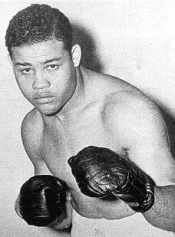 |
Joe Louis Barrow was born on May 13, 1914 to Munroe and Lilly Barrow in a sharecropper’s shack on a cotton farm near Lafayette, Alabama. Two of his grandparents had been slaves. He moved to Detroit with his family, where he went to school for the first time. He also learned to make furniture and worked at an auto body plant there. He learned to box at the Brewster Recreation Center. His first amateur bout was in 1932, and by 1934, he had won the Amateur Athletic Union (AAU) light-heavyweight championship. He was 50 for 54 amateur fights, with 43 by knockout. He had his first professional fight in 1934. Starting with this fight, he won 27 straight, 23 by knockout. Two of Louis’s most famous fights came a few years later against the German fighter, Max Schmeling.
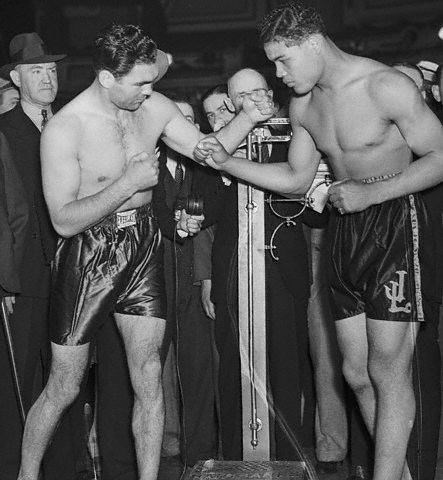 |
Their first fight occurred on June 19, 1936. Schmeling had watched Lois in an earlier fight and spotted a weakness, "I see something. He hasn’t forgotten his amateur mistakes. He drops his left after a lead and tips his head back at the same time. He can be hit with a right hand. I have a good right hand. I will beat him with my right hand." Although he was a former heavyweight champion, he was the 10-1 underdog. The fight lasted until two minutes 29 seconds into the twelfth round, when Schmeling knocked Louis out. Americans were outraged. They started to say that Schmeling had put weights in his gloves, or that someone had “put something in Joe’s water.” Others simply said Louis had sold out, and only cared about the money.
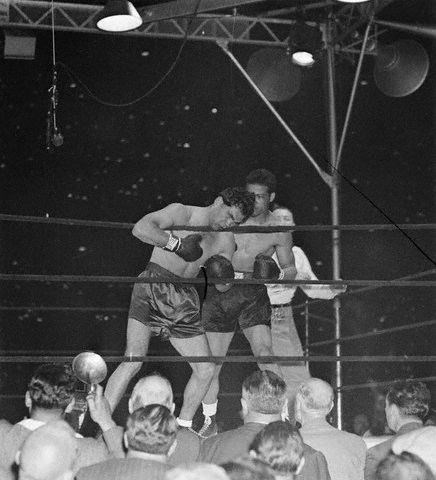 |
Joe Louis won the heavyweight championship of the world in 1937 after he defeated Jim Braddock. Although he was the champion, he said he wouldn’t feel like the true champion until he got his revenge and beat Schmeling. A rematch was set up for June 22, 1938 at Yankee Stadium in New York. Over 70,000 people came to watch, and millions more listened on radios. The match only lasted two minutes four seconds. In that short time, Louis reportedly hit Schmeling over fifty times, causing him to fall three times before the referee ended the fight. Louis had knocked out Schmeling.
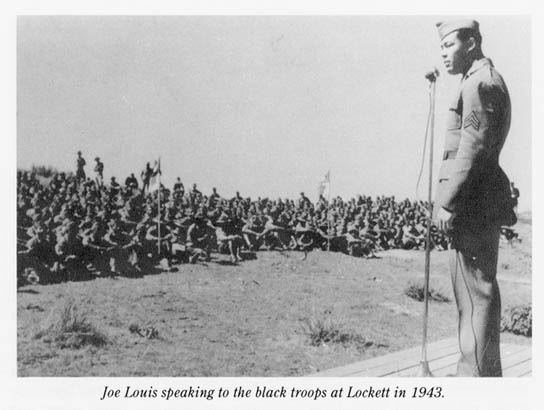 |
The radio wires to Germany were cut when they heard how badly Schmeling had been defeated. He was brought to a hospital, and ten days later was carried on a boat on a stretcher and was brought back to Germany.
He then volunteered for the Army, and fought in exhibition matches all over the U.S., in bouts that came to be known as the “Bum of the Month” campaign. In 1939 alone, he knocked out John Henry Lewis, Jack Roper, “Two Ton” Tony Galento, and Bob Pastor. He has become known as one of the best American boxers of all time. He held the world heavyweight title for eleven years, the longest a title has ever been held. He defended it a record twenty-five times, with twenty-one knockouts. Later on, he had many personal problems, like debt and divorce, but he was most famous for these fights. He wasn’t only representing himself in these fights. He was representing the United States in a much bigger fight. People came to see Max Schmeling as a representative of Nazi Germany. He represented fascism and militarism, and was one of Hitler’s anti-Semitic Aryan “Supermen.” Joe Louis represented America, freedom, and democracy. He was our “Brown Bomber.” Although Schmeling was never a Nazi, and had actually helped save the lives of two German Jews, he was viewed as one. He was picketed throughout New York and the rest of the United States. Before their first fight, many Jewish organizations sent out flyers to storekeepers to boycott the fight. It became bigger than the two fighters. They were now representing two sides of the war. Through all of this, the two became friends. This showed that not all people viewed the Germans as evil, and that not all Germans agreed with the Nazi beliefs. Later in life, when Joe Louis was in debt, Schmeling gave him money to help. They didn’t let their fights affect their friendship. Louis died on April 12, 1981, in Las Vegas, Nevada. Schmeling died on February 2, 2005, at the age of 99, at his home in Hollenstadt. "I don't like money, actually, but it quiets my nerves."Page created on 9/10/2007 12:00:00 AM
Last edited 9/10/2007 12:00:00 AM
Schwartz, Larry. "ESPN.com: 'Brown Bomber' was a hero to all." [Online] Available
Rust Jr., Art. Art Rust's Illustrated History of the Black Athlete. New York: Doubleday & Company, Inc., 1985.
MacCambridge, Michael. ESPN SportsCentury. New York: ESPN, Inc., 1999.
Lovinger, Jay. The Gospel According to ESPN: Saints, Saviors, & Sinners. New York: ESPN, Inc., 2002.
Gipe, George. The Great American Sports Book. New York: Doubleday & Company, Inc., 1978.
